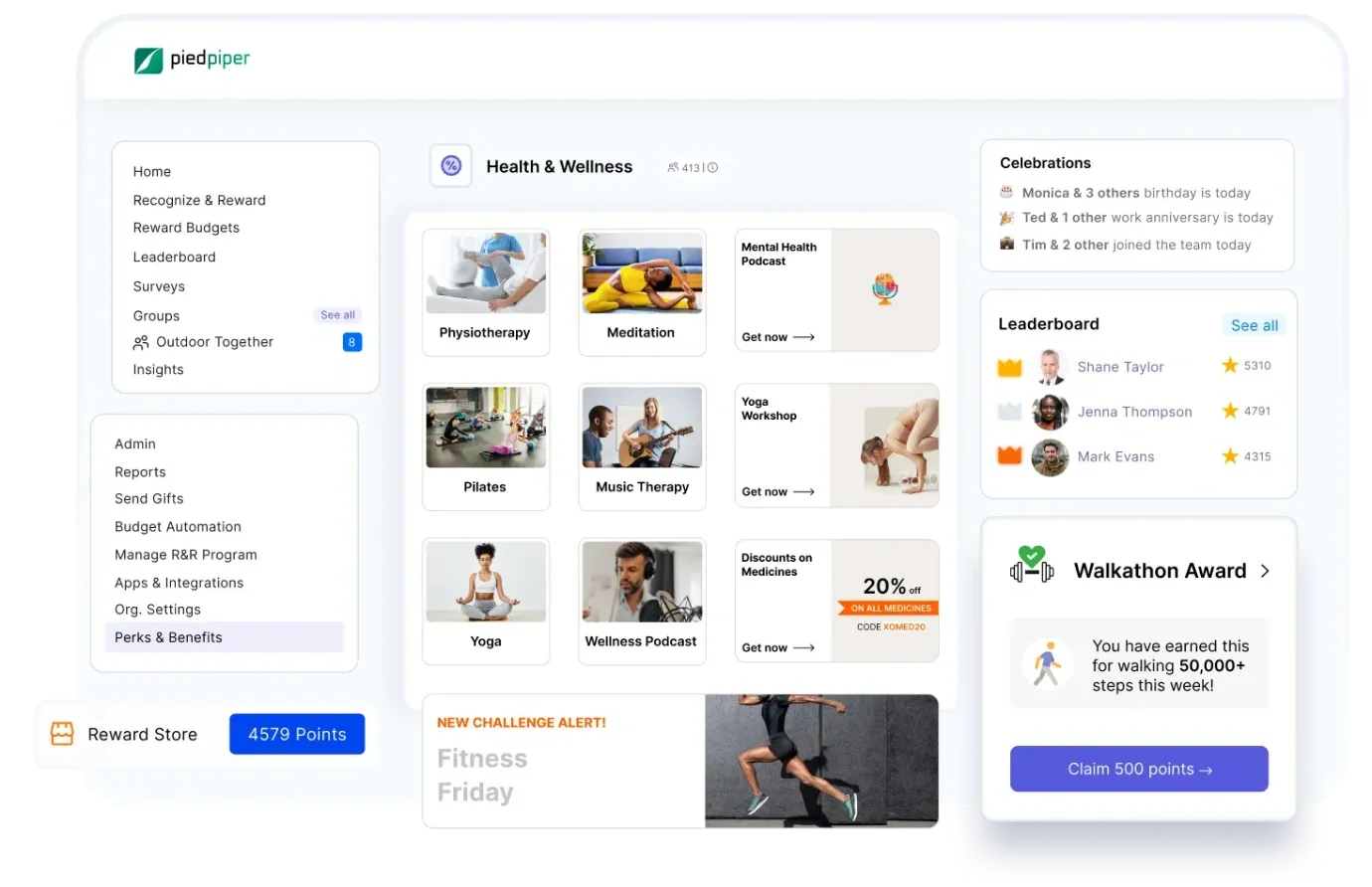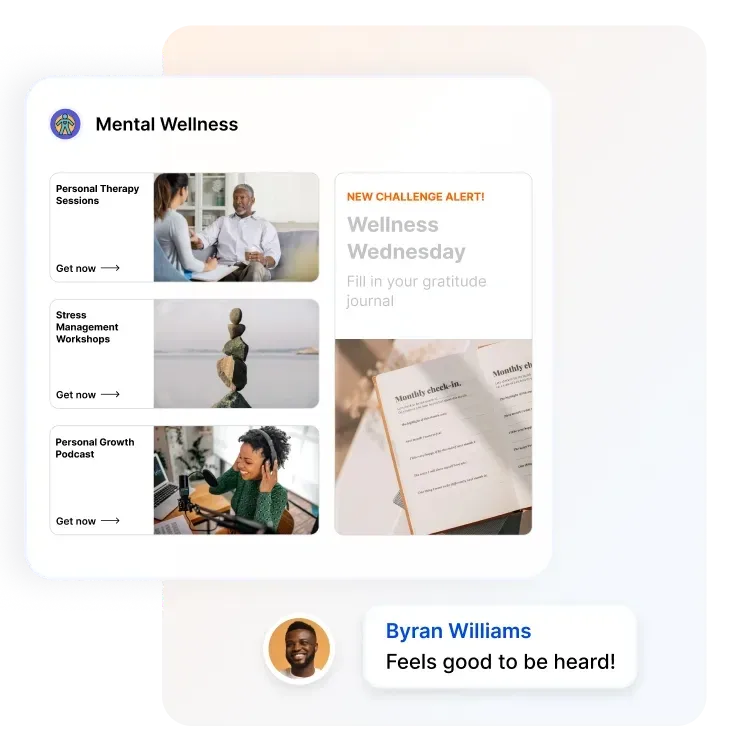The Ultimate Guide to Building an Effective Employee Wellbeing Program
An employee wellbeing program enhances productivity, engagement, and retention. Learn how to create a workplace culture that prioritizes employee well-being and success.
In questa pagina
- Understanding employee wellbeing programs
- I vantaggi dei programmi di benessere per i dipendenti
- Fattori che influenzano il benessere dei dipendenti
- Come non stabilire un programma di benessere sul posto di lavoro?
- Then how do you create effective employee wellbeing programs?
- Top 8 employee wellbeing programs to implement in 2025
- How Empuls enhances employee wellbeing programs
- Conclusione
Ogni azienda desidera che i propri dipendenti siano felici e in salute. Ecco perché oggi molte piccole imprese e grandi aziende iniziano a pensare a come contribuire alla salute e al benessere dei dipendenti.
Since people spend so much of their lives at work, this is a very vital concern for employers.
L'attenzione alla salute mentale e al benessere dei dipendenti sul posto di lavoro non è solo una cosa piacevole da fare, ma è utile per molte aree dell'azienda.
So if you want to keep your best employees and help them do great work, you need to focus on improving employee well-being. But let’s be honest - there are plenty of poorly designed health and wellbeing programs for employees out there.
Come potete quindi essere sicuri di crearne uno per il quale i vostri dipendenti vi ringrazieranno? Dopo tutto, i programmi di benessere sul posto di lavoro funzionano bene solo se i dipendenti partecipano spesso e con entusiasmo.
Non c'è da temere: siamo qui per guidarvi in tutto quello che c'è da sapere sulla creazione di un programma di benessere che piacerà ai vostri dipendenti.
Iniziamo!
Understanding employee wellbeing programs
Employee wellbeing programs focus on improving the physical health of employees at your company.
Le caratteristiche sono diverse per ogni organizzazione, ma molte di esse includono funzioni come programmi per smettere di fumare, sconti per l'iscrizione alla palestra, spuntini salutari in ufficio, gare di step e altro ancora.
Many wellbeing programs are also now beginning to focus on mental health as well as physical. By implementing programs like EAP (Employee Assistance Programs), stress reduction programs, meditation programs, and more.
L'obiettivo è migliorare la salute dei dipendenti rendendo più facile ed economico uno stile di vita sano.
I vantaggi dei programmi di benessere per i dipendenti
Perché i datori di lavoro investono in questi programmi? Possono essere piuttosto costosi, a seconda dei programmi scelti dall'organizzazione.
Ma nonostante il costo e lo sforzo necessario per implementarli, spesso sono molto efficaci e hanno un grande ritorno sull'investimento.
Questo perché i dipendenti felici e in salute sono molto più produttivi e impegnati di quelli stanchi, stressati, preoccupati o malati.
A livello di base, mantenere i dipendenti in salute significa evitare che manchino spesso al lavoro, e questo è ovviamente positivo per il successo dell'azienda. Inoltre, il rapido aumento dei costi sanitari in luoghi come gli Stati Uniti significa che i dipendenti che si ammalano possono rappresentare un enorme spreco di risorse per l'azienda.
Ma essere produttivi e impegnati significa anche che i dipendenti devono ridurre i livelli di preoccupazione e stress nella loro vita, e molti programmi di benessere per i dipendenti più avanzati affrontano anche questo aspetto.
The World Health Organization says that mental illness is now the leading cause of disability and illness. High levels of chronic stress caused by unhealthy workplace cultures have a real impact on employee engagement and productivity.
No one does their best work when surrounded by stressful conditions. But as sad as that sounds, well-designed employee health and wellness programs can help alleviate many of those problems.
Non solo i vostri dipendenti saranno più sani e produttivi, ma si sentiranno anche sostenuti e più felici di lavorare in un'organizzazione che si prende cura di loro con tanta attenzione. Questo significa anche meno turnover e maggiore soddisfazione sul lavoro!
Fattori che influenzano il benessere dei dipendenti
Tre fattori essenziali aumentano la salute e il benessere dei dipendenti sul posto di lavoro: oggi li tratteremo tutti in modo approfondito, così saprete esattamente cosa dovete fare per avere dipendenti più felici, più sani e più produttivi.
1. Controllo del lavoro
One of the biggest factors in employee well-being (and employee engagement) is their discretion over what they do and how they do it. That’s the basis of job control.
Limited job control is linked strongly with poorer physical health, including higher death rates, heart disease, and diabetes.
Anche il controllo del lavoro è un fattore importante per la salute mentale. Numerosi studi hanno rilevato che le persone con livelli più elevati di controllo sul lavoro hanno meno ansia e depressione.
Questi risultati significano che, anche se i lavoratori di livello superiore tendono a svolgere mansioni più stressanti, ad avere maggiori responsabilità e spesso a lavorare per lunghi orari, hanno meno effetti negativi sulla salute a causa della loro carriera, perché hanno livelli più elevati di controllo sul lavoro.
It might seem fairly challenging to increase job control for lower-level workers who are mostly responsible for repetitive, boring tasks where they lack control. But it just takes some imagination to look at a new way to increase job control.
For example, reducing the amount of micromanaging that leaders and managers do is a great first step. While managers certainly need to manage their people, getting too into the details and controlling employees is unhelpful for everyone.
If you’re hiring the right people, you really should be letting them do the jobs they were hired to do with the skills they have and not watching their every move. And even workers infamously tightly controlled phone lines can be given additional autonomy with some creative thinking.
Collective Health empowered its “patient advocates” who answer phones to solve complex patient problems to solve problems on the floor as they come up, instead of giving them a strict script.
This has increased employee retention, satisfaction, and motivation. And it’s proved more efficient at solving customer problems as well - everybody benefits.
2. Motivating employees
Job control doesn’t just affect physical and mental health - it also has a strong impact on how motivated and engaged employees are in their jobs. When employees work in an environment where they don’t have much control over their work or how they get it done, it creates stress and uncertainty.
Potrebbero essere costretti a seguire procedure inefficaci o obsolete e poi essere puniti per gli scarsi risultati ottenuti o avere obiettivi fissati per loro che sono impossibili da raggiungere nel loro ruolo.
Quando questo accade, è difficile per qualsiasi dipendente impegnarsi per andare oltre. Quando non ci si sente padroni dei propri compiti, diminuiscono la competenza e la realizzazione.
That’s not a workplace that encourages you to try your best because it probably won’t be recognized or rewarded if you do. Low job control makes workplaces feel chaotic and unpredictable - you don’t have control over your role or tasks, so it’s hard to predict your actions' outcomes. That is a pretty significant demotivator for most employees.
3. Social support
Avere amici e una solida rete sociale è altamente benefico per la salute e aiuta a ridurre lo stress, compreso quello da lavoro. In molte aziende, però, la vita sul posto di lavoro diminuisce il senso di sostegno sociale e di connessione.
Sembra sorprendente? Non lo è se si considera l'ambiente di molte aziende di alto livello. In molti luoghi di lavoro esistono misure di performance che mettono i lavoratori l'uno contro l'altro, come sistemi di classificazione o promozione a curva forzata. Solo un numero specifico di dipendenti è idoneo per ogni ciclo di revisione.
Altre aziende trattano i dipendenti come se fossero in un rapporto puramente transazionale, in cui il lavoro viene scambiato solo in cambio di denaro.
4. The right employee wellbeing framework
Quando la maggior parte dei datori di lavoro pensa a un programma di benessere per i dipendenti, si concentra sul far sì che questi ultimi adottino autonomamente comportamenti più sani. Ciò può significare smettere di fumare, bere meno, fare più esercizio fisico o mangiare in modo più sano.
In genere i datori di lavoro mettono in atto questi programmi non per concentrarsi sulle esigenze dei dipendenti, ma per ridurre i propri costi sanitari. Questo è il quadro di riferimento sbagliato per il benessere dei dipendenti.
The drivers of unhappy and unhealthy employees are more often factors in the control of employers - unfair workplace practices, unmanageable workloads, lack of role clarity, poor communication, and not enough time to get work done.
Sebbene fare più esercizio fisico e meditare possa certamente ridurre i sintomi dello stress, se il vostro programma di benessere per i dipendenti non affronta le cause alla radice dello stress, non risolverete il problema con uno sconto in palestra.
Dare alle persone carichi di lavoro ragionevoli e un senso di equità sul lavoro contribuirà molto di più a ridurre i costi sanitari legati allo stress.
I dipendenti vogliono anche qualcosa di più di un semplice sconto in palestra per prendersi cura della propria salute, soprattutto se sono troppo stanchi o esauriti dal lavoro per andare in palestra ogni giorno.
5. Improving employee wellbeing
Il benessere dei dipendenti non è solo un aspetto piacevole. È vitale per la salute degli esseri umani che lavorano per voi, ed è anche un fattore positivo per il business.
I dipendenti che non soffrono di alti livelli di stress e burnout sul posto di lavoro hanno il controllo sui loro compiti e forti legami sociali sul posto di lavoro sono più produttivi e impegnati.
Wondering how further to promote that link between employee wellbeing and performance? You can simply ask your employees how they’re regularly feeling to learn how to handle stress at your workplace and what they really want from wellbeing programs. Let’s discuss about employee wellbeing programs.
Come non stabilire un programma di benessere sul posto di lavoro?
Tutti questi vantaggi sono possibili se si scelgono i programmi di benessere giusti, ma vanno perduti se si sceglie quello sbagliato. Che cosa significa?
Tutto ciò che ha lo scopo di aiutare i vostri dipendenti a essere in salute non è forse una buona scelta? Non ve ne saranno grati?
Beh, non sempre. Probabilmente avete fatto un buon lavoro e avete assunto persone molto intelligenti, che si accorgeranno di sforzi che vanno a vantaggio della vostra azienda più che di loro.
Se i vostri programmi di benessere sono pensati principalmente per abbassare i premi assicurativi punendo i dipendenti per comportamenti non salutari, i dipendenti non saranno contenti e non parteciperanno attivamente come vorreste.
As Deloitte has found, there’s actually often a huge gap between what employers think their people need, and what employees actually want. That’s why doing your research properly is vital before you commit to an expensive and unpopular wellbeing program.
And SHRM notes that focusing exclusively on physical wellness is pretty ineffective for most organizations, so it’s better to think holistically about wellbeing.
Then how do you create effective employee wellbeing programs?
Creating a wellbeing program that truly resonates with employees requires more than good intentions—it demands research, personalization, and employee input. Here’s how to do it right:
1. Start with listening: ask, don’t assume
Instead of making assumptions, directly involve employees in the design process:
- Use surveys to understand what employees value most in wellbeing support.
- Ask about stressors, preferred perks, and areas needing improvement.
Tools like Empuls offer lifecycle, eNPS, and pulse surveys with AI-driven insights to uncover employee needs and track sentiment over time.
2. Identify root causes, not just symptoms
Don’t just encourage healthier habits—address systemic workplace stressors:
- Evaluate workloads, fairness, communication gaps, and leadership quality.
- Prioritize job control, autonomy, and social support, which research shows are core to wellbeing.
- Recognize that burnout isn’t solved with a gym pass—it requires structural fixes.
3. Design holistic, flexible programs
Include a variety of initiatives that support:
- Physical wellness: fitness benefits, step challenges, health screenings.
- Mental wellness: therapy sessions, meditation apps, stress management workshops.
- Financial wellness: salary advance programs, tax-saving perks, early wage access.
- Lifestyle needs remote work support, childcare, and learning allowances.
Empuls offers all of the above via customizable Lifestyle Spending Accounts (LSA) and fringe benefits across 50+ countries.
4. Ensure inclusivity & personalization
Avoid one-size-fits-all approaches. Offer choice and flexibility in benefits—e.g., wellness options, rewards, and discounts that reflect different life stages and preferences.
Empuls enables modular configuration of wellbeing programs based on roles, locations, and demographics.
5. Communicate transparently
Even the best program fails without awareness. Ensure clear communication on what's offered and how to access it.
Use internal communication platforms like Empuls Social Intranet to drive awareness, updates, and engagement.
6. Automate for consistency & scale
Automate key touchpoints like:
- Birthday wishes, service anniversaries, wellness nudges, and rewards
- Personalized milestone recognitions to show continuous care
Empuls supports automated workflows and AI nudges to streamline delivery and ensure no moment is missed.
7. Measure impact & iterate
Track participation, sentiment, and ROI:
- Use analytics dashboards to identify what’s working and what’s not.
- Iterate based on continuous feedback to improve adoption and effectiveness.
Empuls provides real-time reporting and people analytics to measure program performance and engagement levels.
By co-creating programs with employees, aligning with their actual needs, and leveraging platforms like Empuls for automation, insights, and personalization, your wellbeing initiatives will be not only effective—but genuinely appreciated.
Top 8 employee wellbeing programs to implement in 2025
Ora che conoscete i vantaggi e le insidie dei programmi di benessere per i dipendenti, quali dovreste prendere in considerazione?
Ecco alcuni dei migliori programmi di benessere che i vostri dipendenti vi ringrazieranno di aver implementato. Non si tratta solo di nostre idee, ma di ciò che i dipendenti di tutto il mondo desiderano davvero (ma non dimenticate di verificare anche con i vostri dipendenti!).
1. Flexible work schedules
Questo potrebbe non sembrare un vantaggio per il benessere, ma in realtà i dipendenti sono più felici e più sani quando hanno un maggiore controllo su dove e quando lavorano.
With so many options for designing flexible work schedules that work for your business, you can provide flexibility and autonomy for your employees so they better balance their work and life together. In fact, Harvard Business Review says that employees thrive when they’re offered these options.
2. Healthy office snacks
Molti datori di lavoro pensano di rendere un grande servizio ai dipendenti fornendo biscotti e caramelle per gli spuntini sul posto di lavoro. Sebbene questo possa essere soddisfacente nel breve periodo, i dipendenti vorrebbero in realtà più opzioni salutari.
Google provides low-cost healthy snacking options in all of its offices, which employees love. And healthy snacks prevent the mid-afternoon sugar crash from sapping productivity out of your employees too.
3. Wellness counseling
Essere sani e in forma può essere una sfida nel nostro mondo frenetico e pieno di cibo. Per i dipendenti che desiderano essere in salute può essere difficile sapere esattamente quali passi compiere.
Ecco perché la consulenza wellness è diventata così popolare come programma di benessere sul posto di lavoro: i dipendenti possono ricevere una guida e un aiuto personalizzati per vivere una vita più sana alle loro condizioni.
4. Mental health counseling
Ottenere aiuto quando si soffre di salute mentale è spesso difficile in molti luoghi. Ma una cattiva salute mentale può portare a gravi problemi sia nel lavoro che nella vita privata.
Aiutare i dipendenti ad accedere a un servizio di consulenza per la salute mentale è molto popolare tra i dipendenti e anche una cosa compassionevole da fare, quindi è un'ottima idea pensare a come offrire questa possibilità.
5. Parental support
Being a working parent is hard for both mothers and fathers. It can be a big challenge to balance work and childcare every day. In fact, US employers lose about $13 billion a year due to lost productivity and earnings due to inadequate childcare.
Offrire supporto, come un generoso congedo parentale retribuito, supplementi per l'assistenza all'infanzia, opzioni di supporto per l'assistenza all'infanzia e altro ancora, può fare una grande differenza nella vita dei genitori che lavorano per voi, che in risposta tendono a essere dipendenti molto fedeli.
6. Destressing programs
Lo stress sul posto di lavoro è un problema diffuso e crescente in molte aziende, forse anche nella maggior parte. Anche se avete fatto sforzi significativi per creare una cultura del lavoro sana e solidale, lo stress può comunque insinuarsi durante le stagioni più intense o in occasione di grandi progetti.
Managing that stress can be hard alone, so implementing programs that help employees learn how to deal with stress can be a big benefit. This could be yoga classes, tai chi, meditation lessons, or other relaxation techniques - Wegman’s offers customized yoga plans for employees, for example.
7. Community involvement
È vero: i dipendenti apprezzano molto la possibilità di contribuire alle loro comunità! Concedere loro permessi retribuiti per fare volontariato o organizzare giornate di volontariato con i vostri team è molto utile per far sentire i vostri dipendenti felici e supportati.
Plus, it benefits the larger community and the image of your business as well. Liberty Mutual Insurance offers annual days of service called Serve with Liberty, which half of their employees across the globe participate in.
How Empuls enhances employee wellbeing programs

Empuls helps organizations design effective employee wellness programs by addressing both physical and mental well-being. With a data-driven approach, it enables HR teams to build workplace wellbeing programs that employees appreciate and actively engage with.
1. Physical wellness: Supporting a healthier workforce

Empuls promotes employee wellbeing by offering flexible options for physical health, allowing employees to choose what suits them best. From fitness challenges with rewards to gym memberships, virtual yoga classes, and nutrition consultations, employees can access a variety of wellness resources that align with their personal health goals. With Empuls, you get:
- Fitness challenges, gym memberships, and yoga classes
- Mental wellness tools: stress management workshops, therapy sessions, meditation apps
- Flexible fringe benefits: Lifestyle Spending Accounts (LSA) for health, travel, meals, learning
2. Mental wellness: Reducing stress and improving focus

To help employees manage stress, Empuls integrates mental wellness solutions into employee wellbeing programs. Companies can offer personal therapy sessions, stress management workshops, and meditation app subscriptions to help employees improve sleep, breathing, and overall mental resilience.
3. Comprehensive benefits for both employees and employers
For HR teams: Fully customizable to fit company-wide workplace wellbeing programs. Scalable across locations and available on all devices. A robust reporting suite with 24/7 access to data-backed insights and actionable recommendations.
For employees: Holistic support across personal, financial, physical, and mental wellness. Exclusive discounts and extended coverage beyond standard insurance. 24/7 customer support, including multilingual assistance, chat support, and a help center.
By leveraging Empuls’ employee wellness solutions, businesses can create a culture that prioritizes employee wellbeing, enhances engagement, and reduces workplace stress, leading to a happier and more productive workforce. Schedule a call now!
Conclusione
Creating an effective employee wellbeing program isn’t just a checkbox exercise—it’s a strategic investment in your company’s most valuable asset: your people. When employees feel physically healthy, mentally supported, financially secure, and socially connected, they bring their best selves to work. The result? A thriving workplace culture, lower attrition, and higher performance across the board.
But getting wellbeing right requires more than good intentions—it demands the right tools, data, and flexibility to meet the diverse needs of your workforce.
That’s where Empuls makes a real difference.
Empuls helps you design, manage, and scale impactful wellbeing initiatives with an AI-powered, data-backed platform that’s loved by both HR leaders and employees alike. From flexible benefits and mental health resources to global perks and continuous feedback loops, Empuls empowers you to build a culture where everyone can do their best work—and feel great while doing it.
Ready to create a workplace your employees won't want to leave? Start your journey with Empuls today. Schedule a call now!












